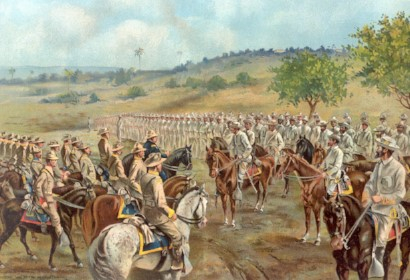 After the destruction of the Spanish warships at the entrance of Santiago’s Harbor, the city was surrounded by U.S. and Cuban troops and the water supply sources at “Cuabitas” were cut off. The Spanish government was in shock. On July 16, 1898, Santiago de Cuba capitulated.
After the destruction of the Spanish warships at the entrance of Santiago’s Harbor, the city was surrounded by U.S. and Cuban troops and the water supply sources at “Cuabitas” were cut off. The Spanish government was in shock. On July 16, 1898, Santiago de Cuba capitulated.
It came at the right time for the U.S. Army. Since landing on June 22, the American forces had lost nearly 10 percent of its strength. Especially hard hit was the volunteer regiment of the “Rough Riders” led by General Leonard Wood and Colonel “Teddy” Roosevelt.
One of the most famous military units in the U.S. Army, (officially the 1st volunteer cavalry regiment) fought as infantry and became a favorite unit for recruitment as soon as it was known that Wood and Roosevelt, both already popular figures, were to lead the regiments. Over 2,500 men volunteered in the first 48 hours of whom 1,200 were accepted to fight in Cuba. They came from all over the United States and ten foreign countries. There were farmers, lawyers, preachers, cowboys, miners, university students and socialite playboys from the northeast. They fought at “Las Guasimas” and San Juan Hill with daring courage and suffered the highest casualty rate of the war (21 percent).
Immediately after the destruction of Admiral Cervera’s warships, the U.S. officers opened negotiations with General José Toral, who had taken over command of the city.
On July 13, under the flag of truce, the Spaniards and American officers went into specific details of the capitulation. That took place under shadow of a large “Ceiba” tree known in Cuba as “El Arbol de la Paz” or the tree of peace.
The articles of capitulation were signed on July 16, and the formal ceremonies were held the following day. The Cuban officers were not present during the surrender negotiations and General William Shafter, an incompetent military leader, denied General Calixto Garcia’s forces, their due right, after years of sacrifices and heroism, to march victoriously into Santiago. Shafter unwarranted order was a painful blow to the Cuban freedom fighters and entered the pages of our history as a display of arrogance.
Shafter order was predicated on grounds of possible retaliation by Cuban soldiers against the Spaniards. This was an unfair assessment. There were isolated cases of reprisal, but the rebel forces that took control of dozens of towns and cities, such as Bayamo, Gibara, Manzanillo, Puerto Padre and Camagüey, kept the peace and protected lives and property.
On September 23, 1898, with General Shafter recalled to the United Sates, Leonard Wood, the newly appointed Governor of Oriente, invited Calixto Garcia and his veterans to enter Santiago de Cuba at the head of his army; it was a glorious day for the cause of independence and vindication for years of sacrifice. The proud army of Cuban freedom fighters marched through the streets of Santiago. Thousand of “Santiagueros” with the Cuban flag and flowers cheered the veteran fighters. They received a hero’s welcome.
* Pedro Roig is Executive Director of the Cuban Studies Institute. Roig is an attorney and historian that has written several books, including the Death of a Dream: A History of Cuba. He is a veteran of the Brigade 2506.









